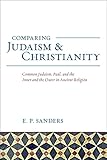Judaism : practice and belief, 63 BCE-66 CE / E.P. Sanders.
Material type: TextSeries: UPCC book collections on Project MUSE | UPCC book collections on Project MUSEPublication details: Baltimore, Maryland : Project Muse, 2016 2015); Minneapolis [Minnesota] : Fortress Press, [2016] 2015)Description: xxix, 892 pages : illustrationsISBN:
TextSeries: UPCC book collections on Project MUSE | UPCC book collections on Project MUSEPublication details: Baltimore, Maryland : Project Muse, 2016 2015); Minneapolis [Minnesota] : Fortress Press, [2016] 2015)Description: xxix, 892 pages : illustrationsISBN: - 9781506406107
- 296/.09/014 23
- BM176 .S257 2016
| Current library | Collection | Call number | Vol info | Status | Date due | Barcode |
|---|---|---|---|---|---|---|
| Judith Thomas Library General Stacks | BKS | BM 176 .S257 2016 (Browse shelf(Opens below)) | AUA24226 | Available | AUA24226 |
Issued as part of UPCC book collections on Project MUSE.
Includes bibliographical references (pages 779-796) and indexes.
Preface -- part I. Context -- 1. Preview -- 2. The issues that generated parties -- 3. Historical outline of the Roman period -- 4. The context of conflict -- part II. Common Judaism -- 5. Common Judaism and the temple -- 6. The ordinary priests and the Levites : at work in the temple -- 7. Sacrifices -- 8. The common people : daily life and annual festivals -- 9. Tithes and taxes -- 10. The priests and Levites outside the temple -- 11. Observing the law of God I : general characteristics, worship and Sabbath -- 12. Observing the law of God II : circumcision, purity, food, charity and love -- 13. Common theology -- 14. Hopes for the future -- part III. Groups and parties -- 15. Aristocrats and Sadducees -- 16. The Essenes and the Dead Sea sect I : origins, history, membership and organization -- 17. The Essenes and the Dead Sea sect II : further aspects of practice and belief -- 18. The Pharisees I : history -- 19. The Pharisees II : theology and practice -- 20. Other Pietists -- 21. Who ran what? -- 22. Epilogue.
Access restricted to authorized users.
In this now-classic work, E. P. Sanders argued against prevailing views regarding the Judaism of the Second Temple period, for example, that the Pharisees dominated Jewish Palestine or that the Mishnah offers a description of general practice. In contrast, Sanders carefully shows that what was important was the "common Judaism" of the people with their observances of regular practices and the beliefs that informed them. Sanders discusses early rabbinic legal material not as rules, but as debates within the context of real life. He sets Pharisees, Sadducees, and Essenes in relation to the Judaism of ordinary priests and people. Here then is a remarkably comprehensive presentation of Judaism as a functioning religion: the temple and its routine and festivals; questions of purity, sacrifices, tithes, and taxes; common theology and hopes for the future; and descriptions of the various parties and groups culminating in an examination of the question "who ran what?" Sanders offers a detailed, clear, and well-argued account of all aspects of Jewish religion of the time.
